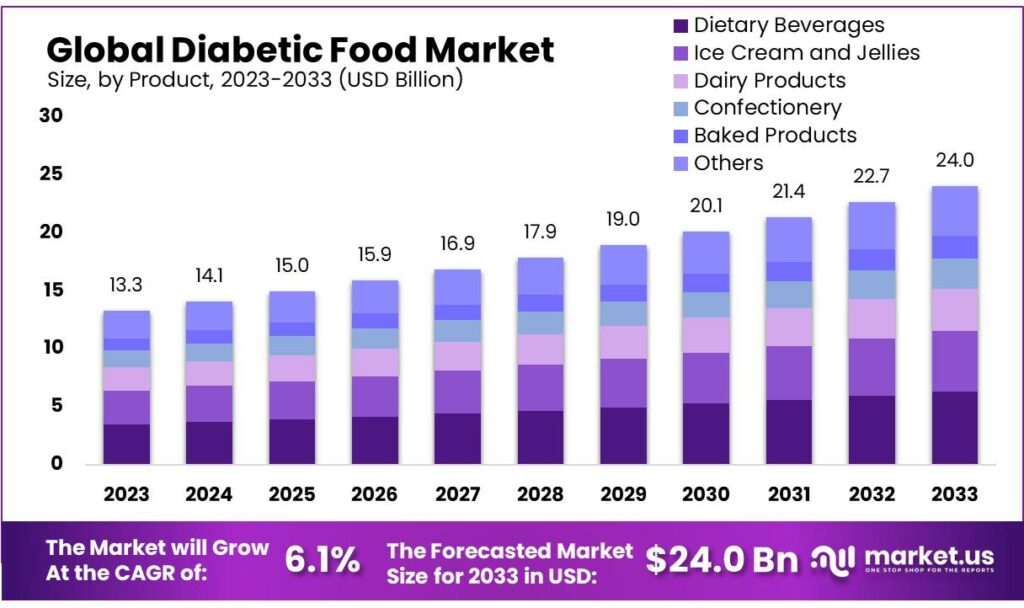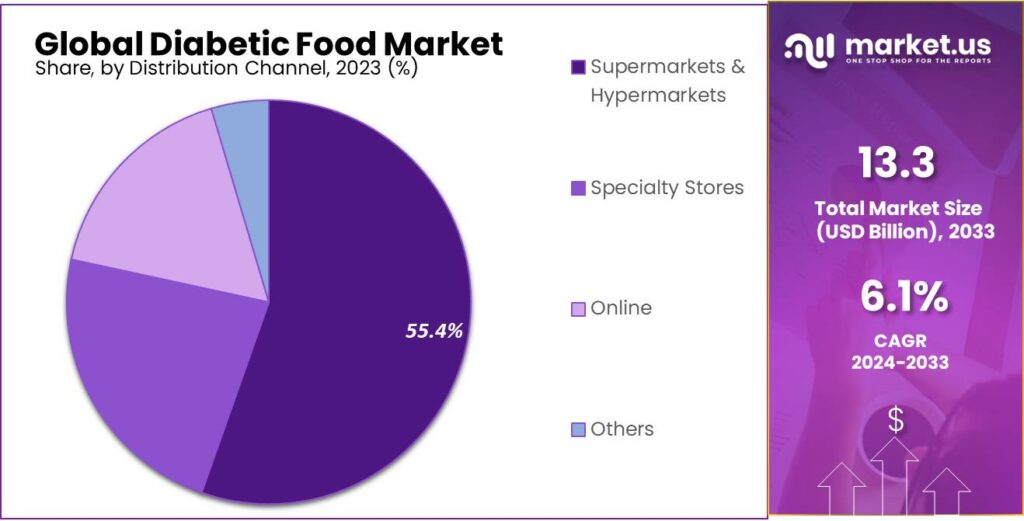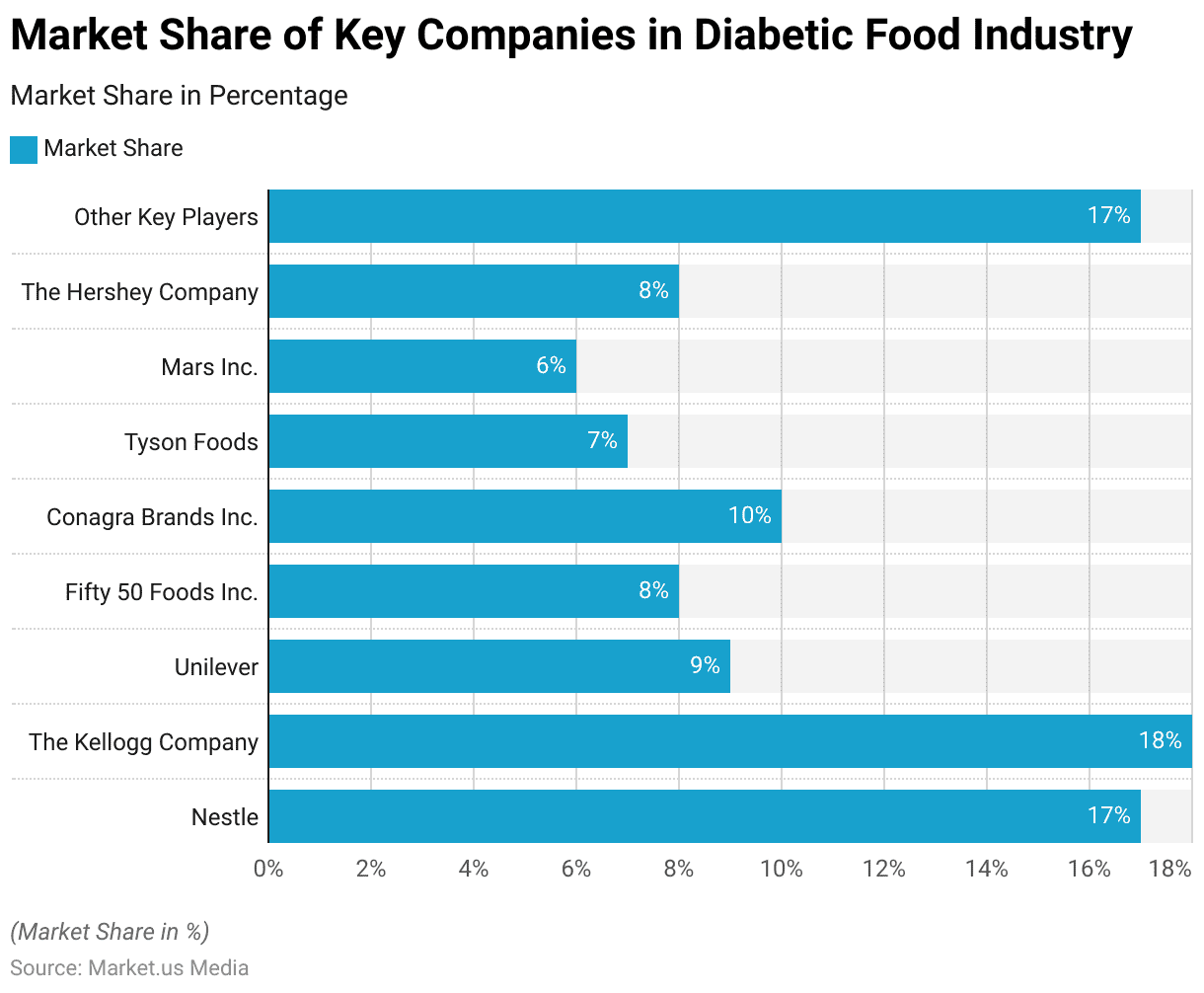Table of Contents
- Introduction
- Editor’s Choice
- Global Diabetic Food Market Overview
- Prevalence of Diabetes in Various Nations
- Nutritional Value of Different Foods Recommended for Diabetic Patients
- Chia Seeds
- Recommended Calorie Intake for Diabetic Individuals
- Retail Sales Value of Digestive and Diabetic/Dietetic Food Products
- Foods with a Low-Glycemic Index Recommended for Diabetic Individuals
- Benefits of Diabetic Food Consumption
Introduction
According to Diabetic Food Statistics, Diabetic food involves careful carbohydrate monitoring, portion control, and emphasis on fiber-rich foods like vegetables and whole grains to stabilize blood sugar levels.
Lean proteins such as poultry and fish, along with healthy fats from sources like avocados and nuts, should be incorporated into meals for satiety and improved insulin sensitivity.
Limiting added sugars and sweets, adhering to regular meal timing, and staying hydrated with water are essential practices.
Individuals are advised to work with healthcare professionals to develop personalized meal plans, monitor blood sugar levels regularly, and make informed dietary choices to manage diabetes effectively.
Editor’s Choice
- By 2033, the global diabetic food market is forecasted to achieve revenues of USD 24.0 billion.
- North America holds the largest market share, accounting for 37.5% of the total market, driven by factors such as a high prevalence of diabetes and increasing consumer awareness regarding healthy dietary choices.
- In the competitive landscape of the diabetic food market, the Kellogg Company leads with an 18% market share.
- At the forefront of the diabetes concern is Pakistan, where a staggering 30.8% of the population falls within the diabetic demographic.
- Generally, experts advise following a daily diet plan ranging from 1200 to 1500 calories to help manage blood glucose levels and maintain a healthy weight. However, these recommendations may differ for each person.
- In 2019, the packaged bakery and cereals industry emerged as the primary driver of U.S. retail success, registering the most substantial sales for digestive health and diabetic/dietetic products, totaling approximately 6.9 billion U.S. dollars.
- According to research published in PLoS Medicine involving over 200,000 participants in the U.S. over 20 years, individuals who predominantly consumed plant-based diets were 20% less likely to develop type 2 diabetes compared to others in the study.

Global Diabetic Food Market Overview
Global Diabetic Food Market Basics
- The global diabetic food market has witnessed steady revenue growth over the past decade, with a CAGR of 6.1%, with revenues reaching USD 13.3 billion in 2023 and projected to increase to USD 14.1 billion in 2024.
- This growth trajectory is expected to continue, with revenues forecasted to reach USD 15.0 billion in 2025, USD 15.9 billion in 2026, and USD 16.9 billion in 2027.
- By 2033, the global diabetic food market is forecasted to achieve revenues of USD 24.0 billion, reflecting sustained growth driven by factors such as rising diabetes prevalence, increasing health consciousness, and the demand for convenient yet healthy snack options among diabetic individuals.

Regional Analysis of the Global Diabetic Food Market
- The global diabetic food market is segmented across various regions, each contributing differently to the overall market landscape.
- North America holds the largest market share, accounting for 37.5% of the total market, driven by factors such as a high prevalence of diabetes and increasing consumer awareness regarding healthy dietary choices.
- Following North America, Europe holds a significant market share of 22.7%, buoyed by a growing diabetic population and stringent regulatory standards promoting the adoption of diabetic-friendly food products.
- The Asia Pacific (APAC) region emerges as another key player, comprising 30.4% of the market share, attributed to factors like changing lifestyles, urbanization, and a rising emphasis on preventive healthcare measures.
- South America and the Middle East & Africa (MEA) regions hold smaller but notable shares, with South America contributing 7.1% and MEA contributing 2.3%, respectively.

Competitive Landscape of the Global Diabetic Food Market
- In the competitive landscape of the diabetic food market, several key players vie for market share, each bringing unique strengths and offerings to the table.
- Leading the pack is The Kellogg Company, commanding an 18% market share, closely followed by Nestle at 17%.
- These multinational giants leverage their extensive product portfolios and global distribution networks to maintain their competitive edge.
- Unilever and Conagra Brands Inc. hold significant shares at 9% and 10%, respectively, while Fifty 50 Foods Inc. and The Hershey Company each capture 8% of the market.
- Additionally, Tyson Foods and Mars Inc. contribute 7% and 6% to the market share, respectively.
- Despite the dominance of these major players, other vital players collectively hold a notable 17% share, indicating a diverse and competitive marketplace.

Prevalence of Diabetes in Various Nations
- In the realm of global health in 2021, the prevalence of diabetes among adults aged 20-79 exhibits notable disparities across various countries and territories.
- At the forefront of this concern is Pakistan, where a staggering 30.8% of the population falls within the diabetic demographic.
- Following closely behind is French Polynesia, with 25.2% of its adult population affected by the condition, followed by Kuwait at 24.9%.
- New Caledonia, the Northern Mariana Islands, and Nauru share an identical prevalence rate of 23.4%, emphasizing the significant burden of diabetes within these regions.
- The Marshall Islands are not far behind, with a prevalence rate of 23%, while Mauritius and Kiribati follow suit at 22.6% and 22.1%, respectively.
- Egypt rounds out the top 10, with 20.9% of its adult population grappling with diabetes.

Nutritional Value of Different Foods Recommended for Diabetic Patients
Leafy Greens
- Per 100 grams of leafy greens, the nutritional profile offers a low-calorie option, providing only 23 kilocalories.
- With a high water content of 91%, leafy greens offer hydration along with essential nutrients. They are also a source of protein, offering 2.9 grams per serving, contributing to muscle maintenance and repair.
- In terms of carbohydrates, leafy greens contain 3.6 grams, with a minimal amount of sugar at 0.4 grams, making them suitable for individuals monitoring their sugar intake.
- Additionally, they are rich in dietary fiber, providing 2.2 grams, which supports digestive health and promotes feelings of fullness.
- Leafy greens are low in fat and contain only 0.4 grams, making them a healthy choice for those watching their fat intake.
Cinnamon
- In a 100-gram serving of cinnamon, the nutritional composition is notable for its high-calorie content, providing 247 kilocalories.
- Cinnamon also offers a moderate amount of protein, with 4 grams per serving, contributing to muscle maintenance and overall body function.
- Carbohydrates make up a significant portion of its composition, totaling 81 grams, while sugar content is relatively low at 2.2 grams.
- The presence of 1.2 grams of dietary fiber supports digestive health and aids in regulating blood sugar levels.
- Additionally, cinnamon contains potassium, providing 431 milligrams per serving, which plays a vital role in maintaining electrolyte balance and supporting heart health.
- Sodium content is minimal, with only 10 milligrams per serving.
Chia Seeds
- In a 100-gram serving of chia seeds, the nutritional profile highlights its dense nutrient content and health benefits.
- With 138 kilocalories per serving, chia seeds offer a moderate energy source, suitable for inclusion in a balanced diet.
- They are rich in healthy fats, providing 8.7 grams per serving, predominantly in the form of omega-3 fatty acids, which are essential for heart health and inflammation reduction.
- Chia seeds are low in sodium, with only 5 milligrams per serving, making them suitable for individuals monitoring their salt intake.
- Carbohydrates are present in chia seeds, totaling 12 grams per serving, with a significant portion coming from dietary fiber, offering 9.8 grams per serving. This high fiber content supports digestive health, aids in satiety, and helps regulate blood sugar levels.
- Chia seeds are free from sugars, making them suitable for those watching their sugar intake.
- Additionally, they provide a moderate amount of protein, with 4.7 grams per serving, contributing to muscle maintenance and repair.
Recommended Calorie Intake for Diabetic Individuals
- Generally, experts advise following a daily diet plan ranging from 1200 to 1500 calories to help manage blood glucose levels and maintain a healthy weight. However, these recommendations may differ for each person.
- Diabetic individuals are typically advised to obtain approximately half of their daily calories from complex carbohydrates.
- For instance, if someone consumes around 1500 calories per day, they should aim to get 600 to 750 calories from carbohydrates.
- Given that carbohydrates provide around four calories per gram, this translates to approximately 150 grams of carbohydrates per day for someone following a 1500-calorie diet plan.
Retail Sales Value of Digestive and Diabetic/Dietetic Food Products
- In 2019, the packaged bakery and cereals industry emerged as the primary driver of U.S. retail success, registering the most substantial sales for digestive health and diabetic/dietetic products, totaling approximately 6.9 billion U.S. dollars.
- In 2019, Canada’s dairy and soy food sector led in retail sales value for digestive health and diabetic/dietetic products, totaling around 1.7 billion U.S. dollars.
- In 2019, the UK experienced packaged bakery and cereals as the top seller of packaged digestive health and diabetic/dietetic products, amounting to roughly 1.7 billion U.S. dollars.
- In 2019, the packaged confectionery category emerged as the leading retail seller of digestive health and diabetic/dietetic products in Germany, contributing to around 2.3 billion U.S. dollars in sales.
Foods with a Low-Glycemic Index Recommended for Diabetic Individuals
- Carrots and other non-starchy vegetables have a relatively low GI of 39, making them suitable choices for individuals aiming to manage blood glucose levels.
- Strawberry jam or jelly falls within the moderate range with a GI of 49.
- Legumes and beans offer a wide range of GI values, typically ranging from 16 to 32, showcasing their favorable effect on blood sugar control.
- Apples and avocados also demonstrate low GI values of 36 and 40, respectively, suggesting they are beneficial options for those seeking to regulate blood sugar levels.
- Meanwhile, bananas have a slightly higher GI of 51, indicating a moderate impact on blood glucose levels.
- Tomatoes round out the chart with a GI of 38, further highlighting their suitability as a low-glycemic index food choice.

Benefits of Diabetic Food Consumption
- According to research published in PLoS Medicine involving over 200,000 participants in the U.S. over 20 years, individuals who predominantly consumed plant-based diets were 20% less likely to develop type 2 diabetes compared to others in the study.
- Moreover, those adhering to the healthiest plant-based diets, rich in fruits, vegetables, nuts, beans, and whole grains, experienced a 34% reduction in their risk of developing type 2 diabetes.
- Conversely, individuals making less healthy dietary choices, such as consuming sugar-sweetened beverages and refined grains, had a 16% higher likelihood of developing type 2 diabetes compared to the rest of the participants.
Discuss your needs with our analyst
Please share your requirements with more details so our analyst can check if they can solve your problem(s)



